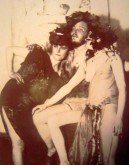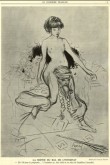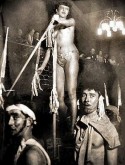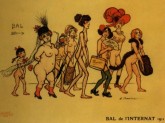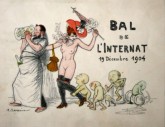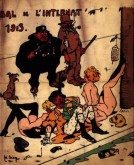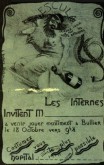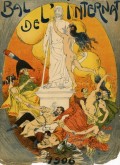The browser will either open the file, download it, or display a dialog.
Introduction
Prior to the success of his novel Phantom of the Opera, Gaston Leroux worked as a journalist for Le Matin. His report on the Bal de l’Internat, published on the morning of October 19, 1897, recounted the previous evening’s event.[1] Students of the École de Médecine had celebrated the last few hours of freedom before they undertook le concours—a series of oral and written examinations that determined the advancement of one’s medical career.[2] The entire Left Bank, Leroux noted, had come alive as medical students, residents, professors, and their guests engaged in fraternal merrymaking, revelry, and ridiculous shenanigans. “Floats, half-sacred, half-profane, though more profane than sacred” animated the Latin Quarter as they “ambled up the Boulevard Saint-Michel heading towards the Boulevard Saint-Germain.” This form of street theater attracted locals and customers who, sitting “on the café terraces” along the route, “stood up and applauded, leaving their drinks, to serve as escorts.”[3] Joined by the curious, medical students—more than one hundred in number—paraded through the Latin Quarter to the Bal Bullier, a popular hall among students notorious for excessive drinking, dancing, and raucous behavior.[4]
This article explores the relationship between the Bal de l’Internat and the construction of a medical esprit de corps in turn-of-the-century Paris. Specifically, it considers the influential role art and artists played in that process. Scholars studying the intersection of the arts and sciences in nineteenth-century France have primarily focused on the visualization of normal and abnormal behavior through medical iconography and the production of ethnographic exhibits at natural history museums and World’s Fairs.[5] Clinical lectures, like those hosted by Jean-Martin Charcot, also encouraged close personal and professional connections between artists and doctors.[6] Recently, hospital breakrooms (salles de garde), where interns and artists met to eat, drink, and paint murals for its walls, have been examined for what they reveal about nineteenth-century medical culture.[7] In 2009, the Musée de l’École de Médecine sponsored an exhibition highlighting the importance of these murals to France’s cultural patrimony and the need to save them from destruction as some of Paris’s oldest hospitals underwent renovations.[8] Writing for the monthly women’s magazine DS, Marie Aline discussed the way in which these images played a unifying role for the medical body, recalling the joys and travails experienced by former interns for those who came after them.[9] Together, artists and interns gave expression to the fragility of life, juxtaposing the euphoric aspects of sex, for example, with macabre motifs of disease and death.[10]
The “quasi-porn” art that dominated salle de garde walls at the end of the nineteenth century represented one way in which interns graphically communicated their concerns and pleasures.[11] Artists also produced illustrations for the Bal de l’Internat, an equally integral but overlooked mechanism in the socialization and initiation of students into the medical corps. This article examines select images taken from posters and invitations produced for the ball over a fifteen-year period. Rather than try to understand these representations in relation to salles de garde murals, this article analyzes the way in which these humorous, sardonic depictions of interns at work and play referenced contemporary anxieties and traditions associated with medical training. Themes of depopulation, degeneration, and sexual desire, it argues, elaborated a vision of masculinity that characterized a medical professional identity in the years leading up to World War I.
The Medical Internat
While internat more generally refers to the physical site where students boarded, it also denoted the four-year apprenticeship that medical students, having successfully passed the concours d’internat, undertook prior to graduation.[12] Created in 1802 when “the old regime artisanal training [of hospital barber-surgeons] was transformed into an elite professional education,” the position of resident (interne) signified a new stage in one’s professional formation within the medical academy.[13]
Whereas the institution of the internat remained unchanged over the course of the nineteenth century, economic and social changes in the last quarter of the century altered the medical student’s experience and cultural outlook. With the professionalization of the medical field came an impulse for bureaucratization. As administrators curtailed their powers and autonomy, doctors and interns submitted to new standards of discipline and behavior.[14] Additional forces, such as increased specialization, the admission of women into medical schools, and a series of recessions, tripled the number of medical school applicants as individuals began to desert “commerce and industry for the liberal professions.”[15] Consequently, the number of students competing for internships exploded, and this heightened one’s sense of belonging to the internat like never before.
Subject to regimented schedules and administrative regulations, interns led what one author described as “an almost monk-like” existence.[16] Little if any separation between one’s personal and professional life existed for an intern who resided in the hospital during those four years. They worked long hours, caring for the sick from sunrise to sunset, and taking charge completely when the service chief was away on holiday or at his private practice. Their health, already weakened by the rigorous study of medical school, deteriorated under the pressure of clinical obligations and sleep deprivation.[17] A 1901 survey published in La Chronique médicale revealed that it was not uncommon for interns, who were typically below the age of thirty, to fall ill, even die, during their residency.[18] Parisian chronicler Louis Morin remarked how the specter of human mortality loomed large for those who, in the prime of their youth, regularly encountered death in the hospitals’ depositories.[19]
Whereas a hierarchical structure within the École de Médecine conferred a degree of seniority that separated interns from those still trying to pass le concours (externs), a culture of egalitarianism pervaded the medical internat. “From the moment one was named intern,” writes Bénédicte Vergnez-Chaignon, “one became equal with all the other interns, regardless of age, experience, specialty, post and honors. . . . There was no hierarchy once the barrier of the concours was crossed.”[20] Solidarity manifested itself in numerous ways, from the interns’ standard uniform of the white apron (tablier) and black velour cap (calotte) (fig. 1) to the collective living arrangement of dormitories and breakrooms.[21] After consulting with service chiefs, performing autopsies, and conducting their daily rounds, interns retreated to the salle de garde. Here, they transmitted a social knowledge that glued this community together.[22] Cult-like practices inherited from their forbears, such as passing plates in a crisscross pattern, and an agreed-upon ban on certain topics of discussion and the use of certain items, visibly displayed the fraternal bonds that separated this body from others [i.e., externs and doctors] within the medical profession.[23] In addition to their annual ball, interns spent time telling jokes, singing songs, writing poetry, and painting murals that voiced and reinforced a core set of beliefs, attitudes, and shared experiences.[24]
The Bal de l’Internat
Originally established as a banquet in 1852, the Bal de l’Internat gave aspiring doctors an opportunity “to blow off steam” before submitting to another year of rigorous training and study.[25] As the one official social release given to medical students, this annual event was also a celebration of equality before the competitive concours, the results of which would determine students’ professional fates. Known as “the most conventional [ball] in the world,” the Bal de l’Internat had, for almost half a century, eschewed the carnivalesque for a solidly bourgeois reputation.[26] With the exception of the year 1885, newspaper and police reports from the 1880s until the mid-1890s describe a civil gathering where medical students and their guests “laughed, danced, and drank” until one in the morning.[27] According to Leroux, the Bal de l’Internat was “above all, a private ball where it was necessary to show white hands [my emphasis]: in this instance, the hand of the medical student (carabin).”[28] This multivalent reference to pale skin alluded not only to the discoloration caused by the constant scrubbing of hands, but also a level of privilege that cast the carabin as a “modern-day aristocrat.”[29] These “children of the bourgeoisie” enjoyed the promise of a lucrative career and a degree of job security as well as a respectability that set elite society apart in the early Third Republic.[30]
The year 1897 marked a drastic departure in the ball’s orientation as evidenced by various press reports that expressed concern, even outrage, over the medical students’ antics. While students proclaimed “their good works and the school’s noble mission,” wrote moral reformer Émile Pourésy, they simultaneously “turned a blind eye to the ‘public spectacle of immorality’” that transpired at the ball.[31] In its description of the ball, the satirical paper La Lanterne reported that “all the young men and their companions were wearing disguises of a crazy appearance.” Added to the ostentatious costumes were the banners, designed and created by each one of the hospitals, which displayed “extremely suggestive drawings” that merged allegory with Rabelaisian realism.[32] Putting reportage and aesthetic analysis aside, the Catholic press La Croix decried the entire affair as an “orgy and sacrilegious parody,” questioning whether “such a school [École de Médecine] should not be closed in the name (and honor of) France and out of respect for the poor and needy.”[33] The irreverence of these young “materialists,” disguised as monks, bishops, and archbishops, offended some priests and mothers who wrote letters to the editor encouraging all Catholics to unite against such lewd displays and to pray for the students’ souls.[34] Although less disparaging in its commentary, the Protestant paper Le Signal was “extremely sad” to hear that the brightest of France’s youth had “organized orgies that recalled the worst memories of ancient Rome’s bacchanals and decadence.”[35]
The transformation of the Bal de l’Internat from a genteel banquet to a boisterous festival (replete with costumes, floats, banners, and a beauty pageant) by the 1890s owed a great deal to the interns’ collaboration with artists attending the École National Supérieure des Beaux-Arts.[36] In addition to their schools being located in the sixth arrondissement, art and medical students shared a cultural affinity that transcended geographic proximity and disciplinary interests. In a piece for the medical journal La Nature, Dr. Felix Regnault remarked on the “mutual sympathy” members of the two academies held for one another noting how “medicine and art have always gotten along.”[37] Both sides referred to each other as “brothers” who frequented the same local haunts, including the Bal Bullier, Montmartre cabarets, and the cafés along the Boulevards Saint-Michel and Saint-Germain.[38] Moreover artists, like Gustave Doré, Henri de Toulouse-Lautrec, and Adolphe Willette, regularly visited salles de garde to socialize.[39] Part of this socializing involved painting murals whose content contrasted with the portraits of famous physicians and medical scenes that appeared within the École de Médecine and more public spaces of Parisian hospitals.[40]
Recognized for his paintings at the Hôpital de la Charité, painter-illustrator Henri Bellery-Desfontaines (1867–1909) provided artistic direction to the Bal de l’Internat beginning in 1897.[41] The artist not only influenced and oversaw the creative process—designing and fabricating costumes, banners, invitations, and floats—but also set the tone for the occasion.[42] “He is the one who created the Bal de l’Internat, who gave these parties a whole other character by instilling in them an artistic note, who, for the first time, decided to build some theater boxes, to synchronize the parades, to organize the contests, and finally to give to the ball the character that it still has today,” wrote artist André Warnod.[43]
Iconography of the Bal de l’Internat
The humor that animated the ball’s posters, invitations, and decoration was one of excess and jubilation. Crossing the hall from its four corners hung streamers which, varying from year to year, carried messages such as, “Laugh hard, we will die fat” and “More bottles: more breasts!” One observer remarked how female guests, “dressed in as little as possible,” straddled carabins’ shoulders while sipping glasses of champagne.[44] More akin to the veils used by belly dancers than those typically associated with face coverings, the sheer fabric worn by some women at the Bal de l’Internat accentuated rather than hid their bodily forms (fig. 2).[45] “Sometimes, a breeze from below lifts the veil of a passer-by. When there is no breeze, it [the veil] lifts up all the same. These ladies make sure of it. They laugh so much they are sick of it.”[46] Graphic artist Jacques Villon (1875–1963) provided visual corroboration for the claim that female nudity was the sartorial rule rather than the exception at the Bal de l’Internat. In a 1908 illustration published in Le Courrier Français, an imposing male figure dressed as a Gaul carries a female reveler on his shoulders. Framed by two contemporary nudes who engage in casual conversations with similarly dressed men, the nude at the center of the composition shows no concern for modesty as she casually exchanges a ticket for her keys and a box of Pastilles Géraudel (fig. 3).
Drawings of a similar nature regularly appeared in the saucy illustrated paper Le Courrier Français after the 1893 Bal des Quat’z-Arts. Established in 1892, the annual artists’ ball of the École National Supérieure des Beaux-Arts provided a template for carabins who wanted to celebrate salle de garde culture in the same way that artists proudly boasted their affiliation with the studio (atelier). With the help of Le Courrier Français’s editor Jules Roques, the Bal des Quat’z-Arts quickly attained notoriety for its display of feminine nudity. Couched in mythological and classical contexts, the presentation of artists’ models as exotic slaves and bare-breasted goddesses led anti-vice reformers to question the presumably artistic intent behind these tableaux-vivants (fig. 4). Charges brought by Senator René Bérenger and La Ligue Contre la License dans les Rues against an art student and four models following the 1893 Bal des Quat’z-Arts led to a trial over whether the exposure of female flesh at the artists’ ball violated public decency. The pronouncement of a guilty verdict resulted in street protests, vandalism, and one death when a week-long melee broke out between the police and those who supported the students’ right to artistic freedom.[47]
The Bal de l’Internat under Bellery-Desfontaines’s leadership embraced the rebellious spirit that characterized the Bal des Quat’z-Arts.[48] Well aware that their actions would draw the attention of public authorities, interns and their artist friends remained undeterred in their critique of bourgeois morality. “Anastasie [the institution of state censorship] watches us and is looking to pick a quarrel with us,” announced La Chronique médicale.[49] Interns expressed a desire to appreciate and study the human form free of academic conventions by employing the contemporary artistic nude to poke fun at hospital rules that forbade women entry into the salle de garde.[50] Defiant references to Senator Bérenger and his efforts to condemn the Bal des Quat’z-Arts appeared in songs and ballads sung in salles de garde and at the ball.[51] The interns’ audacious show of female nudity just four years after the sensational Quat’z-Arts trial proved that, as Leroux jokingly put it, “he [Bérenger] has not come out on top.”[52] With reference to the ball’s more recent sexual overtones, La Chronique médicale proclaimed, “Certainly the spectacle has not always been this appealing!”[53]
Light-hearted depictions of the fun-loving, carefree Montmartroise or Latin Quarter grisette added humor to weighty discussions of depopulation and degeneration treated within the ball’s posters and invitations.[54] While these scantily-dressed women wore the trappings of bourgeois respectability (e.g., plumed hat, fur stole, parasol, spyglass, bonnet, and fan), visual markers such as nakedness, black stockings, and boots identified these working-class women as prostitutes whose bodies allegedly contributed to a decline in the nation’s health through social contamination and moral decay. A 1911 invitation amusingly satirizes their presence at the ball as a threat to the bourgeois social order (fig. 5). A frequent visitor to the hospital Bicêtre’s salle de garde, the novelist Paul Bourget expressed a concern popular within certain intellectual circles that overstimulation of a man’s libido could result in infertility or, worse, emasculation.[55] Elizabeth Menon Mix notes that in his Physiologie de l’amour moderne (1891), Bourget “attributed degeneration in the male not only to the pace of modern life, but also to sexual exhaustion caused by, among other things, frequenting prostitution.”[56] Medical experts like Julien-Joseph Virey helped to legitimize such thoughts. Author of numerous works on vitalism, he popularized the notion that venereal excess, either through masturbation or satyriasis, could result in sexual impotency.[57] Summarizing Virey’s claims about the male sex, Robert A. Nye underscores how anxieties about sexual deviance and youth fed a fin-de-siècle cultural obsession with degeneration: “The more frequent his debauches, especially when undertaken in youth or in extreme old age, the more rapid his decline.”[58]
Questions concerning interns’ social engagement with the communities they served stemmed, in part, from pedagogical debates over the internat as an outdated, elitist, and morally bankrupt institution. Many scholars and public officials viewed the practice of boarding students as a contributing factor to the increased demoralization, frustration, and riotous outbreaks observed in student-populated areas during the late 1880s and early 1890s.[59] According to Judith Sirkus, “Critics charged that this schooling regime separated boys from the moralizing influence of their families, isolated them in promiscuous dormitories, and subjected them to a hard disciplinary order that provoked a seething hatred of authority, and at times outright revolts or ‘mutinies,’ while also encouraging them to passively accept that same authority.”[60] Surkis concludes: “The internat was an institution that everyone loved to hate.”[61] Given a cultural climate that discouraged bachelorhood for demographic and moral reasons, medical students who stayed in this kind of setting well into their adulthood were especially viewed as morally suspect.
In highlighting the inherent contradiction between the interns’ lived experience and society’s expectations of them, depictions of interns alongside prostitutes and fetuses on Bal de l’Internat invitations poked fun at contemporary concerns about their private lives and personal vices. On the one hand, their association with such figures referenced the intern’s unique position within abortion and birth control debates as they were “called upon to maintain the nation’s fitness and superiority against impurity and emasculation.”[62] Under pressure to reduce infant mortality and to ensure a healthy, vigorous population, the medical profession created a corps of obstetric specialists in the 1880s for which some of these young men trained and which they joined.[63] Therefore, the prevalence of fetuses in the Bal de l’Internat’s iconography indicates that as a subject of intense medical inquiry, the fetus had acquired a representational status that directly addressed changes affecting the medical profession and society writ large.
On the other hand, the fetus motif represented both the intern’s professional role in combating depopulation and his personal contribution to the problem. Artists like Henry André playfully highlighted the intern’s derelict constitution in order to expose bourgeois moral prudery for what they really believed it was—hypocrisy.[64] The ball’s posters and invitations depicted the fetus as the product of a union between the sexually independent prostitute and the dissolute intern. In an illustration by Adrien Barrère (1877–1931), the intern’s love of alcohol and sex appears to result in a trail of aborted fetuses or, at best, little degenerate monsters (fig. 6). A correlation can also be made between the intern and the fetal forms which seem to mimic the intern’s provisional professional status and stage of moral development. Like him, these young, mischievous, and drunken creatures will eventually leave their cozy, insulated world, develop large “phalluses and attract nubile women.”[65]
The association of degeneration with the intern’s profligate ways is particularly pronounced in a 1913 invitation for the ball (fig. 7). Charged with “cleaning up the streets,” a police officer and a street sweeper gaze upon a drunken party, presumably in the early morning hours after the ball. Identified by his white glove, a disheveled intern takes center stage in a public spectacle which, once again, involves naked women and an aborted fetus. In addition to the already-established trope of interns consuming the alcohol contained within fetal jars, the invitation makes an explicit allusion to sex by positioning one of the female subjects against a tree dripping with honey. To further underscore the group’s debauched state, a mask and a champagne bottle, two remnants from the ball, lie alongside the revelers. A skull, positioned directly below the supine figure, acts as a memento mori, suggesting not only the morbid repercussions of the intern’s behavior but a zest for life evidenced by his reckless behavior. Salle de garde songs, poems, and art regularly encouraged interns to “seize one’s youth” before becoming a fossile (doctor), a reminder that death symbolically marked the end of the medical internat.[66]
The most salient feature in the ball’s iconography is the presence of alcohol as represented by the bottled fetuses and champagne bottles in figures 6–9. In an 1897 illustration by Bellery-Desfontaines (fig. 8), the Greek god of healing, Asclepius, is coupled with a snake whose wide-open mouth recalls a serpent being milked for its venom. Given the discovery of antivenins by French physician Albert Calmette just two years prior, the invitation presents a modern twist on a traditional symbol for medicine, the snake as the rod of Asclepius. With a bottle in one hand and a chalice in the other, Asclepius beckons the “little externs” to come and enjoy the palliative and beneficial effects the ball has to offer.[67]
While its portrayal in the context of nineteenth-century festivity was not uncommon, the champagne bottle as a recurring motif within the ball’s iconography held added significance when one considers it in relation to salle de garde culture. In keeping with tradition, items invented after the salle de garde’s establishment in the seventeenth century were expressly forbidden.[68] Thus a ban on one of these items, the tire-bouchon (corkscrew), necessitated that interns find other means to open corked bottles.[69] In this context, images of interns wielding champagne bottles could mean many things. For one, these invitations suggest that the apparent predilection interns had for champagne stemmed from rules governing the salle de garde. Like the alcohol contained within the fetal jars, champagne was also more easily accessible and, perhaps, more readily available than wine since neither fetal jars nor champagne bottles required the use of a corkscrew. Furthermore, the bottle itself operated as a visual fetish for the phallus, and when shown uncorked, referred to either the ease by which the subject was sexually aroused or the post-euphoric state in which he found himself. “The eruption of frothy champagne,” writes Patrice Josset, “is an image that very accurately matches masculine ejaculation.”[70] If one applies this reasoning to figure 8, then Asclepius holds out the promise to those seeking admission to the internat that the release of his bottle’s contents has a curative and pleasurable, rather than life-threatening, effect.
A final image, by Gaston Pierre Galey (1880–1959), provides a possible clue for how these allusions to sex and alcohol might have been understood in the context of an intern’s professional development. Galey’s 1906 poster suggests that because of his youth, the intern found himself literally “caught-in-the-middle” between two opposing social groups—one that stood for order, stability, and decorum, the other for frivolity, transgression, and hedonism. This point is illustrated by the figure of the intern who brings these two worlds, represented by two women—one virtuous, the other less so—together (fig. 9). In keeping with descriptive accounts of the ball’s décor, the statue of Hippocrates grounds the composition as he towers over a whirlwind of people drinking, dancing, and making love. On either side of his podium are the two competing worlds that together represent the life cycle of the young intern identified at its base. The viewer’s eye, first drawn to Hippocrates, follows the action as the presumed “Father of Western Medicine” is brought into the feverish mix on the right by a flirtatious nude who offers a toast and raises a glass in his tribute. Unfazed by the serpent whose penetrating tongue appears to perform a sexually deviant act, the female guest falls back in a state of ecstasy into the arms of two men.[71] Disguised as satyrs, these men grope her curvaceous body as clouds of iodoform rise above her head.[72] In the lower right-hand corner, a music-hall dancer throws her leg back as the intern joins hands with a more stately, demure couple on the left.
Dressed in Imperial style, the man and woman seem unfazed by the frolicking that surrounds them. As they direct their gaze to a vaguely defined audience behind the statue, the woman holds her glass up as if to toast the party of revelers. The couples’ participation in the festivity amounts only to their acknowledgement and support of the ball. Their passive pose, backward-looking glance, and outdated clothes suggest the maturation that comes with the completion of one’s medical internship. “They will become serious bourgeois, harsh magistrates, knowledgeable doctors,” wrote a journalist for La Chronique politique, littéraire, économique, “but they will not forget the pagan hours of their youth.”[73] Their presence completes the circle that began with allusions to sexual deviancy and ends with reserve and composure. The intern’s struggle between duty and desire, maturity and youth finds resolution as he and his fellow brothers, wrote Warnod, “eventually become the staunch defenders of order, hierarchy, and privilege.”[74]
Conclusion
The Bal de l’Internat and its iconography reflected an underlying set of conditions that was, at once, specific to the medical profession and yet part of what I call a larger “culture of irreverence” born out of the Belle Époque. Exhibiting all of the hallmarks of a modern-day fraternity party, the Bal de l’Internat celebrated its members and their freedom from middle-class moral and economic obligations, all the while preparing them to assume these obligations. The sexual and sacrilegious aspects that critics, particularly the Catholic press, found offensive about the ball must be understood in relation to the traditions that shaped life within the salle de garde as well as to the current state of the medical profession. When combined with the rituals and symbols passed down from earlier generations, the ball provided a forum where medical students could playfully translate their daily struggles with life and death into an intensely corporeal, hyperbolic expression of carpe diem[75]
Images of well-endowed, inebriated medical students accompanied by women of loose morals and deformed fetuses point to the centrality of sexual pleasure and deviancy as constituent elements in the construction of a medical professional identity in late nineteenth and early twentieth-century France. Influenced by an artistic impulse for bawdy sexual humor and the carnivalesque in turn-of-the-century Paris, interns reaffirmed their mortality and their masculinity through sexually explicit images that mockingly cast aside doubts that their sequestration within the internat had compromised their manhood, or their ability to succeed and lead a robust life. When combined with the eroticized female nude of the Bal des Quat’z-Arts, the Bal de l’Internat’s hyper-masculine image of the intern upheld a tradition of patriarchy that had, up until the late nineteenth century, characterized communal life in Parisian internats and the medical profession for a century. In an era of falling birth rates, changing gender roles, and increasing bureaucratization, artists produced a series of images for the Bal de l’Internat that showed interns snubbing their superiors and inverting social mores in one last salute to their halcyon days.
Acknowledgments: The author would like to thank Eric Segal for his input and advice in the early stages of this article’s development, and Elizabeth Menon Mix and Petra Chu for the helpful comments and insights they provided during the revision process. Robert Alvin Adler deserves special recognition for all of his editorial assistance and patience. All translations are the author’s unless noted otherwise.
The posters and invitations accompanying this article can be found in the Department des Estampes et Photographie of the Bibliothèque Nationale de France, Paris, in Alain Cornec’s Cartes de Bal de l’Internat en Medécine et Chirurgie des Hôpitaux et Hospices Civils de Paris (Grenoble: Boissard, 1985), as well as online. The Association des Salles de Garde maintains a website that offers a history of the Bal de l’Internat, complete with documents, photographic images, and a bibliography. See
http://www.leplaisirdesdieux.fr/LePlaisirDesDieux/LeBal
/CarteAfficheBal2.html.
[1] Gaston Leroux, “Le Bal de l’Internat: Tous les carabins à la Salle Bullier,” Le Matin, October 19, 1897.
[2] From 1901 on, the Bal de l’Internat was held in the month of December, most likely because in 1900 examinations were pushed back to the month of February. This meant that the ball no longer marked the beginning of the concours, which had traditionally lasted from mid-October to late January. See Jacques Fossard, Histoire Polymorphe de l’Internat en médecine et chirurgie des hôpitaux et hospices civiles de Paris (Grenoble: CBUF, 1981), 30.
[3] “Des cortèges mi-sacrés, mi-profanes, plus profanes que sacrés, montaient le boulevard Saint-Michel, se dirigeant vers le boulevard Saint-Germain. . . . Aux terrasses, le peuple des consommateurs se levait, applaudissait, lâchait les consommations, faisait escorte.” Leroux, “Le Bal de l’Internat.”
[4] Roger Shattuck, The Banquet Years: The Origins of the Avant-Garde in France, 1885 to World War I (New York: Vintage Books, 1968), 26; and Barbara Stern Shapiro, Pleasures of Paris: Daumier to Picasso (Boston: Museum of Fine Arts, 1991), 146.
[5] Georges Didi-Huberman first studied the harnessing of art for the purpose of documenting and diagnosing psychiatric disorders. Georges Didi-Huberman, Invention de l’hystérie: Charcot et l’Iconographie photographique de la Salpêtrière (Paris: Marcula, 1982). Since then, Sander Gilman has published several books on the scientific community’s elaboration of the body as a marker of difference through visual culture. See Sander Gilman Disease and Representation: Images of Illness from Madness to AIDS (Ithaca: Cornell University Press, 1988); and Sander Gilman, Picturing Health and Illness: Images of Identity and Difference (Baltimore: Johns Hopkins University Press, 1995). For a discussion of the Paris World’s Fairs, see Paul Greenhalgh, Ephemeral Vistas: The ‘Expositions Universelles,’ Great Exhibitions, and World’s Fairs, 1851–1939 (Manchester: Manchester University Press, 1988); and James Smalls, “‘Race’ as Spectacle in Late Nineteenth-Century Art and Popular Culture,” French Historical Studies 26, no. 2 (Spring 2003): 351–82.
[6] Doctors and medical professors entertained writers and artists at their weekly salons and clinical lectures in the last quarter of the nineteenth century. See Deborah L. Silverman, Art Nouveau in Fin-de-Siècle France: Politics, Psychology, and Style (Berkeley: University of California Press, 1989), 119, 128, 161.
[7] Pierre Darmon, La Vie quotidienne du médecin parisien en 1900 (Paris: Hachette, 1988); Bénédicte Vergnez-Chaignon, Les Internes des hôpitaux de Paris, 1802–1952 (Paris: Hachette Littérature, 2002); Katrin Schlutheiss, Bodies and Souls: Politics and the Professionalization of Nursing in France, 1880–1922 (Cambridge, MA: Harvard University Press, 2001); Patrick Balloul, La Salle de Garde ou Le Plaisir des Dieux (Urrugne: Éditions de Loya, 1993); Patrick Balloul, La Salle de Garde d’hier et d’aujourd’hui (Paris: Éditions de l’Atre, 2005); Patrice Josset, La Salle de garde: Histoire et signification des rituels des salles de garde de médecine, chirurgie et pharmacie du Moyen-Âge à nos jours (Paris: Le Léopard d’Or, 1996); Anne Nardin, Ordre et Désordre à l’hôpital: L’Internat en médecine, 1802–2002 (Paris: Musée de l’Assistance Publique-Hôpitaux de Paris, 2002); Sylvie Baillat, “Les fresques de la salle de garde ou le plaisir des yeux” (PhD diss., Université de Reims), 2003; Emmanuelle Godeau, L’Esprit de corps: Sexe et mort dans la formation des internes en médicine (Paris: Édition de la Maison des Sciences de l’Homme, 2007); Gilles Tondini and Marie L. Bouchon, L’Image obscène: Fresques et graffiti des salles de garde des hôpitaux parisiens (New York: Mark Batty Publisher, 2010); Philippe Paillard, L’Humour médecin: Caricatures et autres dessins humoristiques du monde médical lyonnais, 1890–1950 (Éditions Lyonnaises d’Art et d’Histoire, 2003); Jacques Le Pesteur, Jacques Levy-Stringer, and Didier Farnault, Fresques de salle de garde (Paris: Ramsay, 1980); and Christian Hottin, “Fresques des salles de garde: Artistes et médecins, médecins artistes,” Labyrinthe, no. 14 (Winter 2002-2003): 75–100.
[8] “La salle de garde et la véritable histoire de l’Internat,” La Lettre de l’Association des Amis du Musée de l’Assistance Publique-Hôpitaux de Paris, no. 12 (December 20, 2008): 2; and Éric Favereau, “Hôpital: Fesses en fresques,” Libération, November 24, 2010, 30–31.
[9] “Ce cri est poussé à l’unisson, unifiant du même coup le corps médical.” Marie Aline, “Sexe, fresque, et salle de garde,” DS, September 2007, 76.
[10] Felix Regnault, “La Caricature dans les salles de garde,” La Nature 26, no. 1279 (December 4, 1897): 7–10; and Vergnez-Chaignon, Les Internes des hôpitaux de Paris, 18.
[11] “Beaucoup l’ignorent mais les hôpitaux parisiens recèlent des oeuvres d’art quasi porn.” Aline, “Sexe, fresque, et salle de garde,” 74.
[12] Godeau, L’Esprit de corps, 53.
[13] Leonard Charles Groopman, The Internat des Hôpitaux de Paris: The Shaping and Transformation of the French Medical Elite, 1802–1914 (Ann Arbor: UMI, 1986), 5, 10.
[14] Ibid., 3–4.
[15] “Selon le doyen Brouardel, la crise économique serait un second facteur de pléthore dans la mesure où toutes les périodes de dépression sont marquées par une désertion du commerce et de l’industrie au profit des professions libérales.” Darmon, La Vie quotidienne, 17.
[16] Tondini and Bouchon, L’Image obscène, 16.
[17] Louis Morin, Revue de Quat’ Saisons: Revue trimestrielle illustrée (Paris: Societé d’Éditions Littéraires et Artistiques, 1901), 21–22.
[18] The bi-monthly medical journal La Chronique médicale published a list of forty-one hospital externs and interns who had died between 1875 and 1879. Diphtheria ranked as the top cause of death, followed by typhoid fever. See Darmon, La Vie quotidienne, 95–96.
[19] “Ou encore les journées d’étude à l’École pratique: Les caves, dépotoirs des hôpitaux où la triste fin des malheureux s’exagère par l’horrible mise en scène des cadavres.” Morin, Revue de Quat’ Saisons, 21.
[20] “Dès lors que l’on est nommé interne, on est à égalité avec tous les autres internes, quelles que soient l’âge, l’expérience, la spécialité, les postes et les honneurs. . . . On est dorénavant collègues (et non pas confrères comme avec les autres médecins) et l’on se tutoie (ce qui fut longtemps peu courant). Une fois franchie la barrière du concours, il n’y a pas de hiérarchie.” Vergnez-Chaignon, Les Internes des hôpitaux de Paris, 10.
[21] Groopman, Internat des Hôpitaux de Paris, 41–42.
[22] Tondini and Bouchon, L’Image obscène, 17.
[23] Smoking and the discussion of medicine, politics, and religion during mealtimes were expressly forbidden as were the use of napkins and corkscrews. For an overview of salle de garde rituals, see Josset, La Salle de garde, 27, 37, 39–44; Godeau, L’Esprit de corps, 135, 147–54; and Groopman, Internat des Hôpitaux de Paris, 49–50.
[24] Groopman, Internat des Hôpitaux de Paris, 3, 41, 43, 45–48; Josset, La Salle de garde, 26–30; and Tondini and Bouchon, L’Image obscène, 11, 16–17.
[25] Stuart Henry, Paris, Days and Evenings (Philadelphia: J.B. Lippincott, 1896), 291.
[26] “Elle signifiait que le bal de l’Internat, qui avait lieu tous les ans le plus bourgeoisement du monde, était, cette année, un bal paré et travesti.” Leroux, “Le Bal de l’Internat.”
[27] “Inutile de dire que l’on a beaucoup ri, dansé, et bu.” Jean de Paris [pseud.] as quoted in the “Nouvelles Diverses” section of Le Figaro, October 17, 1890. A report filed by the Prefecture de Police on August 16, 1885 recounts a disturbance involving some women being pulled by the crowd. While no one was seriously injured, the Bullier’s owner decided to bar indefinitely all future Bals de l’Internat from his establishment. See Pierre Guénolé, L’Étrange Passion: La Flagellation dans les moeurs d’aujourd’ hui (Paris: Office Central de la Librairie, 1904), 160–62. A review of the following newspaper articles attests to the refined nature of the ball in the years leading up to 1897: Le Rappel (October 17, 1890, October 26, 1894), Le Matin (October 29, 1893), Le Figaro (October 17, 1890), Le Radical (October 26, 1894), and Le Monde Illustré (June 10, 1893). See also the website Le Plaisir des Dieux, accessed August 2, 2014, http://www.leplaisirdesdieux.fr. Created and maintained by the Association des Salles de Garde des Internes des Hôpitaux de Paris, the website offers a history of the Internat, complete with documents and photographic images of the ball, salle de garde murals, and ephemera.
[28] “Il est également aussi gai et aussi inoffensif, étant, avant tout, un bal privé ou il faut montrer patte blanche: en la circonstance, patte de carabin.” Leroux, “Le Bal de l’Internat.”
[29] “Il serait aussi l’aristocrate des temps modernes, un ingénieur du corps humain, un artiste, un arbitre social, un nouveau prêtre, un demi-dieu anime d’une vocation prométhéenne.” Darmon, La Vie quotidienne, 7.
[30] Louis Comte and Émile Pourésy, Le journaliste au service de la moralité publique (Saint-Antoine-de-Breuilh: Relévement Social, 1935), 171.
[31] Ibid., 170–71.
[32] “Tous les gens et leur compagnes, avaient arboré, par la circonstance des déguisements de folle allure. Et comme dans toute ‘procession’ il faut une bannière, les internes n’avaient pas oublié ce détail, et sur les oriflammes avaient été dressés des dessins suggestifs.” “Le Bal de l’Internat,” La Lanterne, October 21, 1897.
[33] “Elle (La Croix) dénonçait . . . le bal de l’Internat . . . qu’elle traite d’orgie et de parodie sacrilège. . . . Dans sa sotte fureur, La Croix va jusqu’à demander si une telle école (École de Médecine) ne devrait pas être fermée au nom de (l’honneur de) la France et du respect des malheureux.” “Gazette du Jour, Le Bal de l’Internat,” La Croix, October 21, 1897, accessed July 24, 2014, http://gallica.bnf.fr/ark:/12148/bpt6k217548h.image.
[34] “Nous avons déja protesté contre cette initiation et contres diverses plaisanteries tellement odieuses qu’elles laisseraient supposer que certains médecins matérialistes effacent chez eux tout reste de conscience et sont, par suite, capable de bien des choses.” Le Moine [pseud.], “Le Bal de l’Internat,” La Croix, October 20, 1897.
[35] “On dira que la jeunesse intelligente, cultivée de la France, organise des orgies qui évoquent les pires souvenirs des bacchanales de la Rome de la décadence. Nous sommes angoissés, car nous n’avons aucun démenti à donner.” Le Signal as quoted in “Gazette du Jour: Le Bal de l’Internat,” La Croix, October 21, 1897.
[36] Henry André, “Le Bal de l’Internat,” La Chronique médicale 17, no. 22 (November 15, 1910): 744; and Felix Regnault, “Le Bal de l’Internat,” Le Correspondant Médical: Journal médical, scientifique, littéraire, et illustré, no. 147 (November 15, 1900): 8.
[37] “La médecine et l’art ont toujours fait bon ménage. Cette mutuelle sympathie s’est particulièrement manifestée chez les internes de nos hôpitaux parisiens.” Regnault, “La Caricature dans les salles de garde,” 7.
[38] According to legend, Apollo and the Muses visited La Charité’s salle de garde—a place known for “les merveilles”—with the desire to “courir la prétantaine” or womanize. Yet upon their arrival, they expressed disappointment at the bleak and morose atmosphere inside. The interns protested and assured them that they placed a high value on gaiety. Hearing this, Euterpe (the “Giver of Delight”) promised to humanize them, proclaiming that from that time forth “the arts and the sciences are of the same family.” Augustin Cabanès, La Salle de garde: Histoire anecdotique des salles de garde des hôpitaux de Paris (Paris; Montagu, 1917), 71–74.
[39] Darmon, La Vie quotidienne, 280; Cabanès, La Salle de garde, 28, 31, 33, 63, 70; and Vergez-Chaignon, Les internes des hôpitaux de Paris, 18.
[40] Here, I am thinking of André Brouillet’s Une Lecon Clinique (1887) and Henri Gervex’s Avant l’opération dit aussi le docteur Péan enseignant à l’hôpital Saint-Louis sa découverte du pincement des vaisseux (1887), both of which are discussed in Anthea Callen, “Doubles and Desire: Anatomies of Masculinity in the Later Nineteenth Century,” Art History 26, no. 5 (November 2003): 669–99. Over forty-one canvases and sculptures at the 1903 Salon des Artistes Français depicted doctors and surgeons. See Darmon, La Vie quotidienne, 279–80. In his examination of murals and drawings produced by Lyonnais interns, Paillard concludes that scatological humor and puns related to women, figures of authority, and patients characterized salle de garde medical humor in the decades between World War I and World War II. See Paillard, L’humour médecin, 40–41, 57, 64.
[41] André Warnod, Les Bals de Paris (Paris: Les Éditions G. Crès et Cie, 1922), 205.
[42] André, “Le Bal de l’Internat,” 737–38.
[43] “C’est lui qui donna à ces fêtes un tout autre caractère en y mettant une note artistique, c’est lui, peut-on dire, qui créa le Bal de l’Internat, c’est lui qui, pour la première fois, s’est avisé de construire des loges, de régler des defilés, d’organiser des concours, de donner enfin au bal le caractère qu’il a encore aujourd’hui.” Warnod, Les Bals de Paris, 205.
[44] “Des banderoles sont appendues aux quatre coins de cette salles. . . . Quelques-unes: ‘Rions bien: on mourra gras!’ ‘Plus de biberon: des seins!’” “Celles-ci (les femmes) sont aussi peu vêtues que possible.” Leroux, “Le Bal de l’Internat.”
[45] For a history of the veil during the Second Empire, see Marni Reva Kessler, Sheer Presence: The Veil in Manet’s Paris (Minneapolis: University of Minnesota Press, 2006). Traditionally denoting a piece of material that covered a woman’s face, the meaning and function of “la voile” changed markedly in the last half of the nineteenth century as the entertainment and fashion industries experimented with the staging of women’s bodies.
[46] “Quelquefois, un voile qu’un passant soulève en soufflant dessous. Quand on ne souffle pas, il se soulève tout de même. Ces dames y veillent. Elles rient tant qu’elles en sont maladies.” Leroux, “Le Bal de l’Internat.”
[47] Lela Felter-Kerley, “The Art of Posing Nude: Models, Moralists, Artists and the 1893 Bal des Quat’z-Arts,” French Historical Studies 33, no. 1 (Winter 2010): 69–97.
[48] Warnod, Les Bals de Paris, 205.
[49] “Anastasie nous observe et pourrait nous chercher noise.” Diafoirus and Desfonandrès [pseud.], “Le Bal de l’Internat, du 15 décembre 1902,” La Chronique médicale 10, no. 1 (January 1, 1903): 12. ‘Diafoirus’ and ‘Desfonandrès’ were two pseudonyms taken from characters in Molière’s Le Malade imaginaire (1673) and L’Amour médecin (1665). Anastasie was a soubriquet for the institution of state censorship. Whereas censorship of the press had been abolished in 1881, theatrical censorship existed until 1904. See Sally Debra Charnow, “The Politics of Preventive Censorship,” in Theater, Politics, and Markets in Fin-de-Siècle Paris (New York: Palgrave MacMillan, 2005).
[50] By the 1880s, the excessive coming and going of female guests into the salle de garde led the Assistance Publique to pass measures regulating their entry. Although hospital administrators officially forbade interns from entertaining female guests on the institutions’ grounds, they turned a blind eye when interns snuck women into their dormitories or invited famous dancers, like Mimi Pinson, to perform. See Cabanès, La Salle de garde, 15; Un Fossile, “Impressions d’un Fossile sur le bal de l’Internat de 1910,” La Chronique médicale 17, no. 23 (December 1, 1910): 787. By the early 1890s, one finds the sequestration of interns from their female companions serving as a backdrop for several Belle Époque novels and plays that explored the erotic subtext of the doctor-patient relationship. Interest in the study of sexuality and psychology likewise fueled a production of literary works about interns’ private lives. See, for example, Adolphe Tabarant, Virus d’amours (Paris: H. Kistemaeckers, 1886); Jules Claretie, Amours d’un interne (Paris: E. Dentu, 1899); Paul Bourget’s Drames de famille: L’Échéance le luxe des autres coeurs d’enfants (Paris: Plon-Nourrit et cie., 1900); and Edmond de Goncourt and Jules de Goncourt, Soeur Philomène (Paris: A. Bourdilliat et Cie, 1861). See Cabanès, La salle de garde, 28–31; and Darmon, La Vie quotidienne, 99.
[51] E. Lepage, “Le Bal de l’Internat en 1903,” La Chronique médicale 11, no. 1 (January 1, 1904): 5; Un Fossile, “Impressions d’un Fossile,” 787.
[52] “La vérité nous force à avouer que M. Bérenger n’a pas gagné au change.” Leroux, “Le Bal de l’Internat.”
[53] “Grace à notre anneau de Gygès, nous avons pu, une fois de plus, tout voir sans être vus, et certes le spectacle ne fut pas toujours ragoûtant.” Diafoirus and Desfonandrès, “Le Bal de l’Internat,” 10.
[54] The term “grisette” dates back to the early stages of industrialization in France when a wave of young women from the countryside came to Paris in search of work in the garment industry. Identified by the gray dresses they wore, grisettes lived and worked in and around the Latin Quarter. Their close proximity to and relationships with young men contributed to a romanticized vision of the grisette as an attractive, independent, and sexually available woman. See Jerrold Siegel, Bohemian Paris: Culture, Politics, and the Boundaries of Bourgeois Life, 1830–1930 (Baltimore: Johns Hopkins University Press, 1986), 39–42.
[55] Cabanès, La Salle de Garde, 29–31.
[56] Elizabeth K. Menon, Evil by Design: The Creation and Marketing of the Femme Fatale (Urbana-Champaign: University of Illinois Press, 2006), 218.
[57] J. J. Virey, De la puissance vitale considerée dans ses fonctions physiologiques (Paris: Crochard, 1823).
[58] Robert A. Nye, “Honor, Impotence, and Male Sexuality in Nineteenth-Century French Medicine,” French Historical Studies 16, no. 1 (Spring 1989): 48–71.
[59] Leading critics of the internat included Minister of Public Education Jules Simon (1870–73), literary critic and historian Hippolyte Taine, and author Maurice Barrès. Judith Surkis provides the most comprehensive treatment of how social reformers and intellectuals tried to align France’s educational system with values emphasized under the Third Republic; namely, family, conjugality, moral autonomy, and sexual discipline. See her chapter “Wasted Youth,” in Sexing the Citizen: Morality and Masculinity in France, 1870–1920 (Ithaca: Cornell University Press, 2006).
[60] Ibid., 74.
[61] Ibid.
[62] Carolyn Dean, Sexuality and Modern Western Culture (New York: Twayne Publishers, 1996), 8.
[63] Groopman, Internat des Hôpitaux de Paris, 111–13.
[64] André, “Le Bal de l’Internat," 737.
[65] Groopman, Internat des Hôpitaux de Paris, 220–21.
[66] Ibid., 48; and Josset, La Salle de garde, 33.
[67] The author would like to thank Elizabeth Menon Mix for drawing a correlation between the positioning of the snake’s mouth and the history of antivenin drugs in France.
[68] In a chapter entitled “Les Ancêtres de l’internat,” Cabanès dates the origin of the internat to 1613 when Parisian hospitals began the practice of feeding and lodging medical students. See Cabanès, La salle de garde, 5–10. In order to create cohesion and solidarity among its members, the medical internat performed rituals that were reportedly practiced within the first salles de garde. See Josset, La Salle de garde, 57–60.
[69] Ibid. 55–59.
[70] “Il est évident que l’ouverture du champagne au sabre dans ce sens plus particulièrement caractéristique: en effet l’expulsion du bouchon et du haut du goulot suivie de l’irruption de champagne mousseux est une image très fidèlement parallèle à l’éjaculation masculine. Ibid., 55.
[71] Typically associated with themes of greed, temptation, and original sin, the snake could simultaneously represent “a substitute phallus” on the one hand, and an alliance between women and the devil on the other. See Menon, Evil by Design, 235.
[72] Analogous to chloroform, iodoform was an odorous antiseptic used to clean and heal wounds in the nineteenth century. The association of the smoke-like puffs, illustrated in the 1906 invitation, with this compound is suggested by the following quote: “Il se passe des choses qui, paraît-il, ne se passent que là . . . cependant qu’au-dessus des danses, au-dessus des chants, au-dessus de cette orgie tout à fait spéciale, une vague odeur d’iodoforme plane.” Leroux, “Le Bal de l’Internat.”
[73] “Ils deviendront des bourgeois sérieux, des magistrats sévères, des médecins savants mais il n’oublieront pas ces heures païennes de jeunesse.” Stephane, “Le bal de l’Internat,” La Chronique politique, littéraire, economique, November 1, 1913, 688.
[74] Warnod, Les Bals de Paris, 205.
[75] Groopman, Internat des Hôpitaux de Paris, 6, 201–2.



